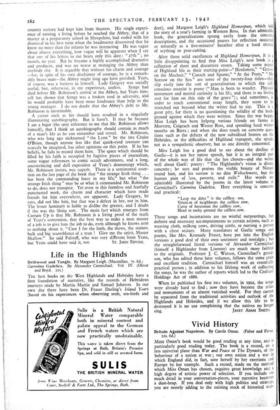Life in the Highlands
THE best books on the West Highlands and Hebrides have a firm foundation of narrative, like the records of Hebridean journeys made by Martin Martin and Samuel Johnson. In our own day there have been Dr. Fraser Darling's Island Years (based on his experiences when • observing seals, sea-birds and deer), and Margaret Leigh's Highland Homespun, which told the story of a year's fanning in Western Ross. In that admirable book, the generalisations sprang easily from the concrete descriptions, and the occasional pauses for reflection occurred as naturally as a five-minutes' breather after a hard stretch of scything or peat-cutting.
After those solid excellences of Highland Homespun, it is a little disappointing to find that Miss Leigh's new book is a collection of short and discursive essays. Taking some aspect of Highland life as their starting-point—" Herdsmen," " Grave;
on the Machair," " Canach and Spume," " At the Peats," " My Sorrow on the Sea " are some of the twenty-four titles—they slip easily into the sort of generalisation to which the self- conscious essayist is prone (" Man is born to wander. Physical movement and mental curiosity is his life, and there is no lasting rest for him on .this side of the grave "); and sometimes, in order to reach conventional essay length, they seem to be stretched out beyond what the writer had to say. This is a great pity, for there is no questioning the solidity of the back- ground against which they were written. Since the war began, Miss Leigh has been helping various friends on farms in Morvem, Coigeach and Wester Ross, and spending hard winter months on Barra ; and when she does touch on concrete ques- tions such as the defects of the new subsidised houses on the Hebrides, or the difficulties of Highland transport, she speaks not as a sympathetic observer, but as one directly concerned.
Miss Leigh has a good deal to say about the decline of Gaelic—it is not her native speech, but it is an integral part of the whole way of life that she has chosen—and she writes well about Gaelic poetry : " The Highlander's vision is direct, concrete ; he sees and praises the visible beauty of Nature round him, and his sorrow is no dim Weltschmerz, but the human pain of loss, poverty, and exile." Her words are admirably illustrated by the poems in the latest volume or Carmichael's Carmina Gadelica. Here everything is concrete and practical: "Leap the dyke" is the calfless :ow, Vexatim of neighbours the calffess cow, Curse of herdsman the calfless cow, Head to rocky ground the calfless cow.
These songs and incantations are no wistful outpourings, but definite and necessary accompaniments to certain actions, such as weaving cloth, milking cows, driving cattle, or nursing a person with a chest seizure. Many translators of Gaelic songs and poems, like Mrs. Kennedy Fraser, have put into the English versions a good deal of their own sentiment and nostalgia ; but the straightforward literal versions 'of Alexander- Carmichael (himself a Highlander from Lismore) are much more faithful to the originals. Professor J. C. Watson, Carmichael's grand- son, who ,has edited these later volumes, follows the same plain and excellent tradition. Carmichael himself was an essentially practical person ; in addition to his lifelong work of collecting the songs, he was the author of reports which led to the Crofters' Holdings Act of 1886.
When he published his first two volumes, in 1902, the songs were already hard to find ; now they have become the relics and monuments of an almost vanished world. For they cannot be separated from the traditional activities and outlook of the Highlands and Hebrides, and if we allow this life to be destroyed it is no use complaining that the natives no longer


























 Previous page
Previous page